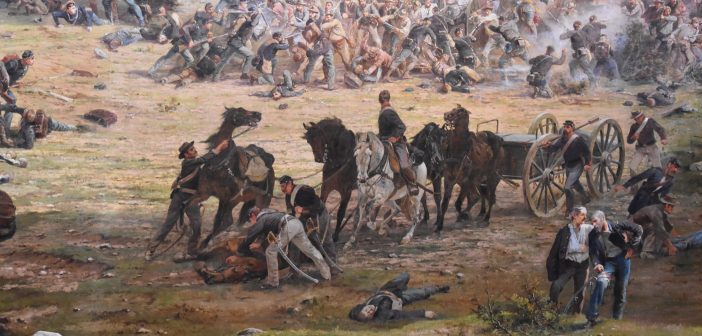By Sue Boardman & Elle Lamboy | Photo Courtesy of Adams County Historical Society
You may find this hard to believe, but “The Battle of Gettysburg” cyclorama painting has even more to it than meets the eye.
Yes, the painting is magnificent in its own right. It measures 377 feet by 42 feet and thrusts the viewer into the middle of what many historians believe was the turning point of the entire Civil War—Pickett’s Charge.
But we’re encouraging you to
look closer.
Confederate Gen. Robert E. Lee ordered the infamous charge depicted in the painting on the third day of the Battle of Gettysburg. Approximately 12,000 Confederate soldiers charged against about 6,500 Union soldiers at Cemetery Ridge. The Union Army prevailed that day; the Confederate Army, especially Gen. George Pickett’s division, suffered massive casualties. Pickett is known for never forgiving Lee for ordering the catastrophic charge. In fact, when Lee asked Pickett to rally his men following the charge, he allegedly answered, “General, I have no division.”
The cyclorama dramatically depicts this horrific scene. But, it also shows a little insight into the artist, Paul Philippoteaux’s, journey to creating
the painting.
Philippoteaux was not a Civil War veteran, nor an American citizen (he was born in Paris), so he needed to do a lot of research before beginning his work. While conducting some field research, Philippoteaux reportedly ran into brothers Peter and Robert Bird, who were both Battle of Gettysburg veterans. The brothers likely traveled to Gettysburg for a battle reunion but were walking the battlefield paying their respects and reminiscing.
The brothers told Philippoteaux and his assistants about their war experiences, primarily their Gettysburg story. They fought in the 24th Michigan regiment, which is part of the well-known Iron Brigade. Both brothers suffered wounds on July 1. Peter was hit on the right thigh, and Robert on the right arm and left ear. After the war, both brothers settled in their hometown of Romulus, Mich. While a famous regiment, the 24th Michigan never fought in Pickett’s Charge. They were actually stationed at Culp’s Hill on the third day of battle.
Yet, Peter and Robert Bird appear in the Gettysburg cyclorama painting. This is one of those instances that encourages you to look closer.
Though the brothers did not fight in Pickett’s Charge, Philippoteaux wanted to honor them for their help in his research and their military service by including them in the cyclorama
painting. Philippoteaux uses several clues to reveal the brothers’ portrait is part of the painting’s story versus the story of the Charge.
The Gray Gives It Away
According to their war records, the brothers were 18 and 21 years old when they fought in the Battle of Gettysburg. Yet, Philippoteaux painted them as they appeared when he met them nearly 20 years after the Battle of Gettysburg, with gray hair and aging features.
Their Wounds Are Well Cleaned and Dressed
Despite being in the middle of heavy battle action, the brothers’ wounds are completely cleaned and dressed. Philippoteaux is honoring their service by painting them with the wounds they described to him when they met. Once
a soldier suffers a war wound, it sticks around long after the bleeding stops.
Their Positioning Is Suspect
The brothers are not engaged in the battle action at all. They are facing the viewer. This likely symbolizes that they are recalling what is going on behind them and aren’t active participants.
According to their family history, the brothers were later given a sketch of themselves depicted in the painting from Philippoteaux or one of his assistants.
The Bird brothers aren’t the only hidden story in the cyclorama painting. The Gettysburg Foundation offers two different programs, An Evening with the Painting and Secrets of the Cyclorama, which delve into the Bird brothers and several other cyclorama mysteries and hidden portraits. For more information, visit www.gettysburgfoundation.org.
Sue Boardman is a licensed battlefield guide, Cyclorama historian, author, and the leadership program director for Gettysburg Foundation. Elle Lamboy is the director of membership and philanthropic communications for Gettysburg Foundation, a nonprofit educational organization working with the National Park Service to enhance preservation and understanding of the heritage of Gettysburg and its national parks. Gettysburg Foundation also owns and operates Gettysburg National Military Park Museum and Visitor Center. Visit www.gettysburgfoundation.org.




